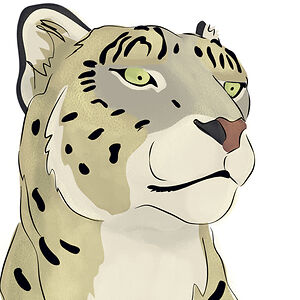Maneki Neko are Japanese talisman intended to attract good luck and good fortune. You might know them as; Beckoning Cat, Future Cat, Good Luck Cat, or Feng Shui Cat. They are popular in many Asian cultures and therefore have many different names, legends, lore, and significances attached to their various details.
I love these statues, and as a snow leopard and ambassador of cool things, I decided to stage a photo shoot to model some examples! I had to do it twice because the first pictures did not come out very well. And, I want to thank my smartphone assistant, Luna, for helping me. I could not have done this without her.
In this article, I’ll walk you through common gestures and body positions of the Maneki Neko. We’ll look at some of the objects that these cat statutes might possess, as well as the different colors and their meanings. Afterward, I’ll bring it all together in a photo gallery featuring me, Cane. Let’s go!
The Paws: Beckoning or Waving?
A traditional Maneki Neko statute has a raised paw with its toes folded downward, depicting a beckoning gesture that is common in many Asian cultures. In this way, the Maneki Neko is calling forth or beckoning good fortune, health, wealth, and good luck to bless its owner.
Some contemporary statues can be found with the underside of the paw showing depicting a “waving”, Western-style greeting. I have even seen Maneki Neko gesturing the peace sign.
Which Paw Up?
Because these statutes are popular in different Asian cultures, there are different interpretations of the body positions.
Maneki Neko invites good luck and fortune by raising their right paw. I found some statutes with paws stretched higher above their heads than others. These express a desire for more luck or for luck to arrive in the future.
If the left paw is up, then the Manki Neko is beckoning customers. These are commonly found outside of businesses.
Both paws raised can signify many meanings. Some people claim they are beckoning for protection. Or for a combination of attracting customers and good fortune, the two attributes as assigned to each paw above. Others say that two paws up represent greed or giving up. Even still, some believe it means longevity for 10,000 years.
Bib-Collar-Bell
Here I am, modeling the traditional Maneki Neko uniform, which consists of a bib, collar, and bell. Red is the most common color for the collar. Other color options are pink, gold, green and black.
Historical records depict Maneki Neko wearing kimono during the Edo period.
Objects Held by the Maneki Neko: Koban
The Koban is an oval-shaped coin from the Edo Period of Japan and represents wealth. This is by far, the most common object that you will find a Maneki Neko holding.
Objects Held by the Maneki Neko: Uchide no kozuchi
The uchide no kozuchi is a magic wishing hammer. It is a wooden hammer that when shaken, can bring forth whatever you wish.
I wish for a dry cappuccino with extra chocolate sprinkles.
Objects Held by the Maneki Neko: Carp
Japanese Koi Carp are the national fish of Japan and a symbol of good luck, prosperity, and good fortune.
No koi/ carp were harmed in the creation of this article.
Objects Held by the Maneki Neko: Orb
A Maneki Neko holding an orb, gem or marble encourages wisdom and knowledge for its owner.
Objects Held by the Maneki Neko: Daikon Radish
The daikon radish is a large root vegetable that represents a bountiful harvest, plenty, and abundance. It is not very common to find these in the paws of a Maneki Neko, which makes them extra special- I think.
Colors
Maneki Neko statues are made in a variety of colors. Each color representing a unique property.
– Calico is the most traditional and the most auspicious.
– White might be the most common, celebrates happiness, purity, and overall good fortune.
– Gold represents wealth and prosperity.
– Black Maneki Neko wards off evil spirits and bad luck.
– Pink is the color of sakura, cherry blossoms, and encourages romantic success and love.
– Red promotes good health.
– Green Maneki Neko is for safety and is related to getting good grades in school.
– Blue is very rare, they represent peace and safety.
Gallery: #1 Lucky Black Cat Wards of Evil and Invites Financial Prosperity
Maneki Neko in black is the lucky black cat that chases off evil spirits. There will be no bad luck here!
In this picture, I’m holding a Koban, to attract wealth. Together, I’m chasing away bad luck and evil spirits that might plague a business or individual’s personal finances. I am so brave.
Gallery #2 Calico with Carp and Koban with Right Paw Up Invites Good Luck
The Carp kept tickling me!
Japanese Koi are a type of carp and a traditional symbol of prosperity. No carp were harmed during the making of this photo. And, of course, I used gentle catch and release methods. Which method, you ask? I asked her for a photo op.
Gallery #3 Calico with Magic Mallet and Daikon Radish, Wishing for Abundance
Go Big or Go Home!
Here I am holding the magic wishing mallet and extra-large daikon radish.
While daikon radishes themselves are not specifically associated with wealth, their large size symbolizes abundant harvest.
Gallery #4 Custom
As an inspiring social media influencer, I couldn’t resist creating this one. It’s me, Cane, in my cashmere social media life hoodie, holding the verification symbol. Around my neck is a trendy red collar in vegan leather, darning a 10k medallion. And, my Amethyst Eyewear is by Don & Doña. Notice how I look off into the distance as if I am not concerned with what’s in front of me? This is my signature modeling move.
I’m not at 10,000 followers yet, I hope this article will help. You can follow me on Instagram @commandercane


















4
0